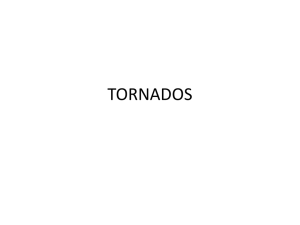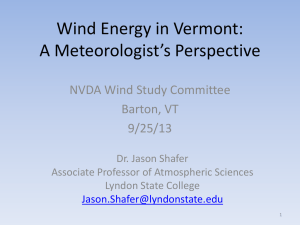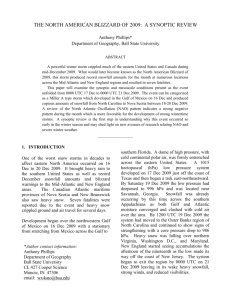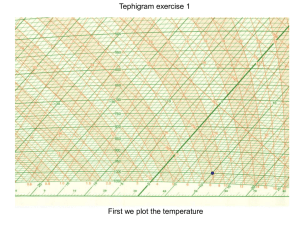Regional Variability and F - cstar
advertisement
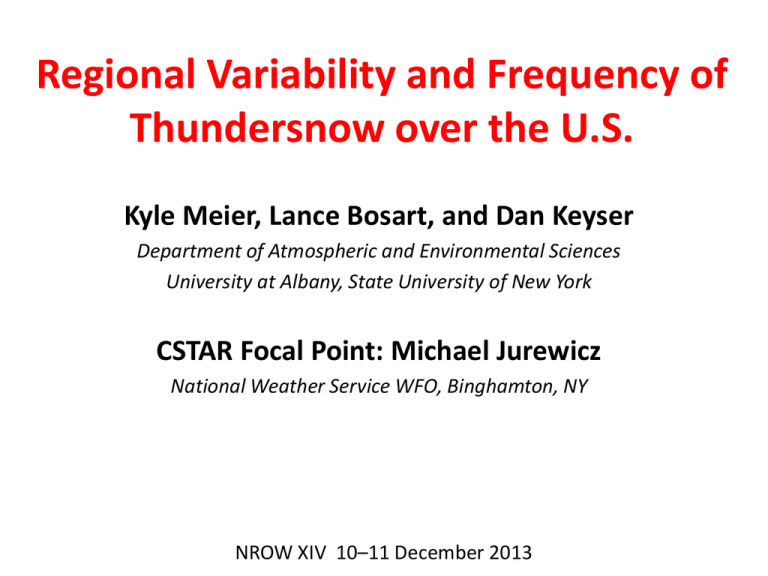
Regional Variability and Frequency of Thundersnow over the U.S. Kyle Meier, Lance Bosart, and Dan Keyser Department of Atmospheric and Environmental Sciences University at Albany, State University of New York CSTAR Focal Point: Michael Jurewicz National Weather Service WFO, Binghamton, NY NROW XIV 10–11 December 2013 Importance o Thundersnow events can produce mesoscale regions of locally enhanced snowfall accumulations (6–12 in.) and intense snowfall rates (2–4 in. h−1) o Relatively little is known about thundersnow • • Rarity of such storms compared to both non-thundering snowstorms and summertime thunderstorms Lack of direct observations inside clouds that produce lightning o The rarity of thundersnow events presents a significant forecasting challenge when they do occur Background o Convective storms require the collective contribution of: • • • Moisture Instability Lift o Fourth ingredient needed specifically for thundersnow to occur: cold air • Below-freezing temperatures within clouds and near the surface o Lightning production requires an interaction between different types of ice in clouds • Separation between ice crystals (+) and graupel (−) can result in an electric field that becomes large enough to produce an electrical spark (i.e. the lightning stroke) Background Thundersnow can occur in a variety of mesoscale and synoptic-scale settings: o Lake-effect o Orographic lift o Coastal storms and coastal fronts o Thundersnow ahead of warm fronts (elevated convection) o Thundersnow in the vicinity of cold fronts (anafronts) o Thundersnow associated with Alberta Clippers Background Thundersnow can occur in a variety of mesoscale and synoptic-scale settings: o Lake-effect o Orographic lift o Coastal storms and coastal fronts o Thundersnow ahead of warm fronts (elevated convection) o Thundersnow in the vicinity of cold fronts (anafronts) o Thundersnow associated with Alberta Clippers TSSN Climatology (Methodology) o Objective: Construct a thundersnow climatology in order to establish the spatial and temporal distribution of TSSN reports across the contiguous U.S. o Period of Study • • 19 years: 1994–2012 Cool season: October–March o Dataset: Total Surface Archives (Weather Graphics Technologies) • • • Comprehensive archive of hourly METAR surface observations Off-hour (SPECI) surface observations also included All valid AWOS and ASOS stations TSSN Climatology (Methodology) o Scan observations for all instances of TSSN, VCTSSN, TSPL, and TSGS during the period of study o Manually eliminate reports from Alaskan stations, Canadian stations, and eliminate “false positives” o Tsurface < 4°C o Multiple consecutive reports (i.e. separated by less than 12 h) at a single station constitute one count in the climatology o Compile statistics o Plot the reports spatially on a map of the U.S. TSSN Climatology (Overview) o 2667 reports extracted o TSSN was reported at 680 stations in the contiguous U.S. o 46 of 48 states reported thundersnow (exceptions: Delaware and Florida) o Single, isolated TSSN reports were common • Reinforces the notion that TSSN is a fairly localized phenomenon of limited duration o Other instances where TSSN occurred at several adjacent stations and/or for several consecutive hours 1994–2012 Thundersnow Climatology Legend 1–2 reports 3–5 reports 6–10 reports 10–20 reports 20+ reports 1994–2012 Thundersnow Climatology Intermountain West Legend 1–2 reports 3–5 reports 6–10 reports 10–20 reports 20+ reports 1994–2012 Thundersnow Climatology Intermountain West Central U.S. Legend 1–2 reports 3–5 reports 6–10 reports 10–20 reports 20+ reports 1994–2012 Thundersnow Climatology Intermountain West Central U.S. Northeast Coast Legend 1–2 reports 3–5 reports 6–10 reports 10–20 reports 20+ reports 1994–2012 Thundersnow Climatology Great Lakes Intermountain West Central U.S. Northeast Coast Legend 1–2 reports 3–5 reports 6–10 reports 10–20 reports 20+ reports NLDN Data to Supplement Reports Legend METAR report NLDN lightning flash 12 February 2006 Hypotheses o The intermountain west maximum in TSSN reports is likely due in part to orographic forcing (and lake-enhanced effects near the Great Salt Lake) o The maximum in the central U.S. is likely associated with the relatively high frequency of extratropical cyclone activity o Reports near the Great Lakes stations suggest a lake influence (if not actual lake-effect events) o Some East Coast events may have benefited from mesoscale forcing provided by coastal fronts associated with coastal cyclones and their ability to tap warm, moist oceanic air Thundersnow Annual Distribution 800 700 19 Year Counts 600 500 400 300 200 100 0 October November December January February Month **Cursory analysis suggests there is not a strong diurnal preference for TSSN to occur March Thundersnow Capital of the U.S.? Copper Mountain, CO 135 reports (5.07%) Thundersnow Capital of the U.S.? Wolf Creek Pass, CO 114 reports (4.28%) Rounding out the top 10… 3. Beckley, WV 50 reports 4. Salida Mountain, CO 48 reports 5. Pagosa Springs, CO 29 reports 6. Telluride, CO 28 reports 7. Ely, NV 27 reports 8. Sunlight Mountain, CO 24 reports 9. Ogden Hill, UT 19 reports 10. Bedford, MA 19 reports Thundersnow Reports by State 1. Colorado 516 reports 2. Minnesota 379 reports 3. Illinois 219 reports 4. Oklahoma 197 reports 5. Nebraska 100 reports 6. Texas 99 reports 7. Wisconsin 98 reports 8. Michigan 84 reports 9. West Virginia 73 reports 10. New York 71 reports **The top 10 states comprise ~68% of the total reports Two Case Studies from the 2012–2013 Winter Season o 8–9 February 2013 • A historic blizzard associated with a deep cyclone produced widespread snowfall totals of 20–40 inches across parts of New England. TSSN was reported in five states: NY, CT, MA, RI, and NH. o 16–17 February 2013 • A strong cold front moved across the Carolinas on the morning of 16 February. Later in the afternoon, the main upper-level trough moved across the Carolinas, resulting in a second round of precipitation. TSSN was reported across several locations in NC and SC. Methodology o Objectives: (1) Compare the synoptic-scale and mesoscale features associated with the two events and (2) Identify the relevant dynamical and thermodynamic reasons for the observed thundersnow o Datasets • Plan view charts (0.5° GFS data) • Cross-sections and proximity soundings (13-km RUC) • 0.5° WSR-88D radar reflectivity mosaics and NLDN data Plan View Analysis 0000 UTC 9 February 2013 0000 UTC 17 February 2013 1000–500-hPa thickness (dashed, every 6 dam), mean sea level pressure (black, every 4 hPa), and 250hPa wind speed (filled, every 10 m s−1 starting at 40 m s−1) Plan View Analysis 0000 UTC 9 February 2013 * Coupled jet system with a strong jet entrance region to the north 0000 UTC 17 February 2013 * Strong jet core (90 m s−1) well to the east of observed TSSN 1000–500-hPa thickness (dashed, every 6 dam), mean sea level pressure (black, every 4 hPa), and 250hPa wind speed (filled, every 10 m s−1 starting at 40 m s−1) Plan View Analysis 0000 UTC 9 February 2013 0000 UTC 17 February 2013 * Strong jet core (90 m s−1) well to the east of observed TSSN * Coupled jet system with a strong jet entrance region to the north * 984 hPa surface cyclone SE of Long Island, NY, and a 1036 hPa anticyclone in Quebec * Absence of a strong cyclone. 1024 hPa anticyclone over WI advecting cold air into the Southeast 1000–500-hPa thickness (dashed, every 6 dam), mean sea level pressure (black, every 4 hPa), and 250hPa wind speed (filled, every 10 m s−1 starting at 40 m s−1) Plan View Analysis 0000 UTC 9 February 2013 0000 UTC 17 February 2013 500 hPa geopotential height (black, every 6 dam), geostrophic absolute vorticity (filled, every 4 x 10-5 s−1), and wind barbs (kts) Plan View Analysis 0000 UTC 9 February 2013 * Northern and southern stream short-wave troughs merge ~ 0200 UTC, coincident with a maximum in observed lightning 0000 UTC 17 February 2013 * Deep longwave trough associated with lowest heights of ~528 dam 500 hPa geopotential height (black, every 6 dam), geostrophic absolute vorticity (filled, every 4 x 10-5 s−1), and wind barbs (kts) Radar and Observed Lightning 0230 UTC 9 February 2013 2145 UTC 16 February 2013 B A ++ ++ + +++ +++ + A’ B’ 0.5° radar reflectivity mosaics and observed CG lightning flashes (black plus signs) Cross-section Analysis 0300 UTC 9 February 2013 2100 UTC 16 February 2013 Cross sections of θe (red, every 4 K), absolute geostrophic momentum (black, every 10 m s−1), and relative humidity (filled, every 10% starting at 80%) Cross-section Analysis 0300 UTC 9 February 2013 WMSS 2100 UTC 16 February 2013 WMSS Cross sections of θe (red, every 4 K), absolute geostrophic momentum (black, every 10 m s−1), and relative humidity (filled, every 10% starting at 80%) Cross-section Analysis 0300 UTC 9 February 2013 2100 UTC 16 February 2013 Cross sections of θes (black, every 4 K), negative ω (dashed, every 3 μbar s−1 starting at −12 μbar s−1), frontogenesis [filled, every 2 K (100 km)−1 (3 h)−1], and the −10°C and −20°C isotherms Cross-section Analysis 0300 UTC 9 February 2013 2100 UTC 16 February 2013 Mixed-phase region Mixed-phase region Cross sections of θes (black, every 4 K), negative ω (dashed, every 3 μbar s−1 starting at −12 μbar s−1), frontogenesis [filled, every 2 K (100 km)−1 (3 h)−1], and the −10°C and −20°C isotherms Cross-section Analysis 0300 UTC 9 February 2013 2100 UTC 16 February 2013 ω = −21 μbar s−1 ω = −33 μbar s−1 Mixed-phase region Mixed-phase region Cross sections of θes (black, every 4 K), negative ω (dashed, every 3 μbar s−1 starting at −12 μbar s−1), frontogenesis [filled, every 2 K (100 km)−1 (3 h)−1], and the −10°C and −20°C isotherms Sounding Analysis 0300 UTC 9 February 2013 2100 UTC 16 February 2013 Vertical temperature and dewpoint profiles at New Haven, CT (HVN) Vertical temperature and dewpoint profiles at Rock Hill, SC (UZA) Sounding Analysis 0300 UTC 9 February 2013 * CAPE: 0 J kg−1 * 700−500 hPa lapse rate: 6.3°C km−1 * LCL: 669 hPa * Winds veer with height in lower troposphere Vertical temperature and dewpoint profiles at New Haven, CT (HVN) 2100 UTC 16 February 2013 * CAPE: 210 J kg−1 * 700−500 hPa lapse rate: 7.4°C km−1 * LFC: 940 hPa * EL = 535 hPa * Winds back with height in the lower troposphere Vertical temperature and dewpoint profiles at Rock Hill, SC (UZA) Sounding Analysis 0300 UTC 9 February 2013 * CAPE: 0 J kg−1 * 700−500 hPa lapse rate: 6.3°C km−1 * LCL: 669 hPa * Winds veer with height in lower troposphere 2100 UTC 16 February 2013 * CAPE: 210 J kg−1 * 700−500 hPa lapse rate: 7.4°C km−1 * LFC: 940 hPa * EL = 535 hPa * Winds back with height in the lower troposphere * Entire tropospheric column below freezing 0°C Isotherm Vertical temperature and dewpoint profiles at New Haven, CT (HVN) Vertical temperature and dewpoint profiles at Rock Hill, SC (UZA) Conclusions o Two thundersnow events from February 2013 occurred in very dissimilar synoptic-scale environments • Case #1: NW quadrant of a strong coastal cyclone and was associated with the merger of two shortwave troughs • Case #2: Post-cold-frontal environment and associated with a deep 500 hPa trough o Similarities: Near-saturated conditions, weak MSS, and strong updrafts in the lower-to-middle troposphere over the range of temperatures corresponding to the mixed-phase region of a thundercloud Future Work o Surface observations alone will not reveal all TSSN events • NLDN observations can fill in these gaps (provided the lightning strokes are CG) o Generate constant-pressure and vertical-profile composites of the environment preceding and during the occurrence of thundersnow • The composites may help determine the dynamical and thermodynamic processes that contribute to regional TSSN frequency and variability o Conduct representative case studies of the various TSSN pathways o Determine discriminators between TSSN events and nonthundering snow events

